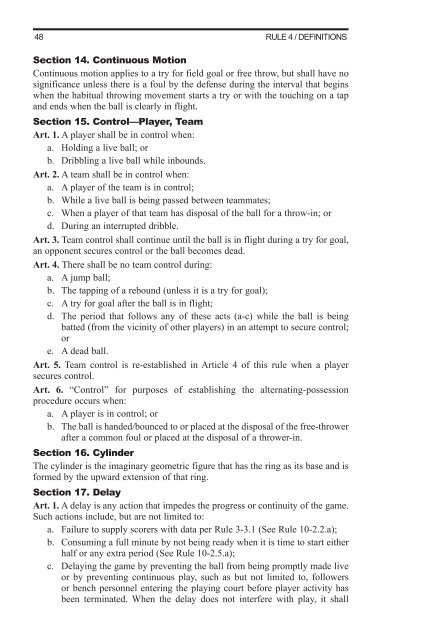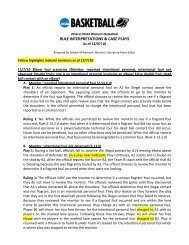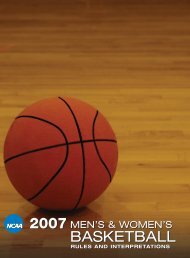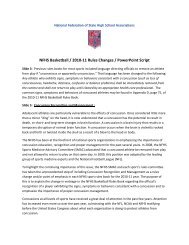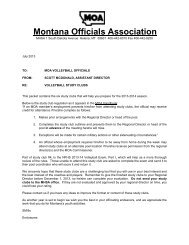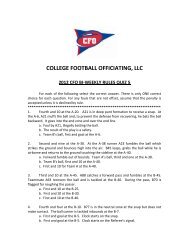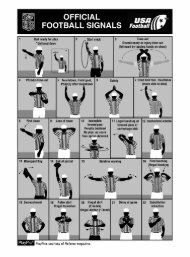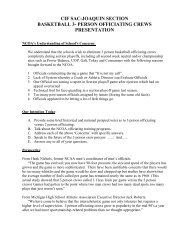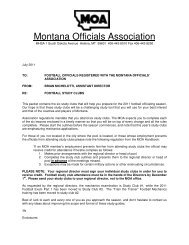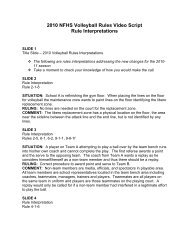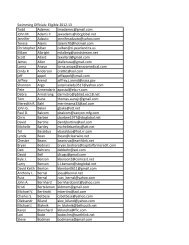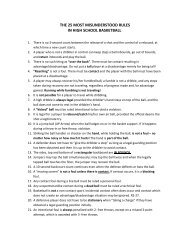2011-12 AND 2012-13 MEN'S AND WOMEN'S RULES - NAIA
2011-12 AND 2012-13 MEN'S AND WOMEN'S RULES - NAIA
2011-12 AND 2012-13 MEN'S AND WOMEN'S RULES - NAIA
You also want an ePaper? Increase the reach of your titles
YUMPU automatically turns print PDFs into web optimized ePapers that Google loves.
48<br />
RULE 4 / DEFINITIONS<br />
Section 14. Continuous Motion<br />
Continuous motion applies to a try for field goal or free throw, but shall have no<br />
significance unless there is a foul by the defense during the interval that begins<br />
when the habitual throwing movement starts a try or with the touching on a tap<br />
and ends when the ball is clearly in flight.<br />
Section 15. Control—Player, Team<br />
Art. 1. A player shall be in control when:<br />
a. Holding a live ball; or<br />
b. Dribbling a live ball while inbounds.<br />
Art. 2. A team shall be in control when:<br />
a. A player of the team is in control;<br />
b. While a live ball is being passed between teammates;<br />
c. When a player of that team has disposal of the ball for a throw-in; or<br />
d. During an interrupted dribble.<br />
Art. 3. Team control shall continue until the ball is in flight during a try for goal,<br />
an opponent secures control or the ball becomes dead.<br />
Art. 4. There shall be no team control during:<br />
a. A jump ball;<br />
b. The tapping of a rebound (unless it is a try for goal);<br />
c. A try for goal after the ball is in flight;<br />
d. The period that follows any of these acts (a-c) while the ball is being<br />
batted (from the vicinity of other players) in an attempt to secure control;<br />
or<br />
e. A dead ball.<br />
Art. 5. Team control is re-established in Article 4 of this rule when a player<br />
secures control.<br />
Art. 6. “Control” for purposes of establishing the alternating-possession<br />
procedure occurs when:<br />
a. A player is in control; or<br />
b. The ball is handed/bounced to or placed at the disposal of the free-thrower<br />
after a common foul or placed at the disposal of a thrower-in.<br />
Section 16. Cylinder<br />
The cylinder is the imaginary geometric figure that has the ring as its base and is<br />
formed by the upward extension of that ring.<br />
Section 17. Delay<br />
Art. 1. A delay is any action that impedes the progress or continuity of the game.<br />
Such actions include, but are not limited to:<br />
a. Failure to supply scorers with data per Rule 3-3.1 (See Rule 10-2.2.a);<br />
b. Consuming a full minute by not being ready when it is time to start either<br />
half or any extra period (See Rule 10-2.5.a);<br />
c. Delaying the game by preventing the ball from being promptly made live<br />
or by preventing continuous play, such as but not limited to, followers<br />
or bench personnel entering the playing court before player activity has<br />
been terminated. When the delay does not interfere with play, it shall


